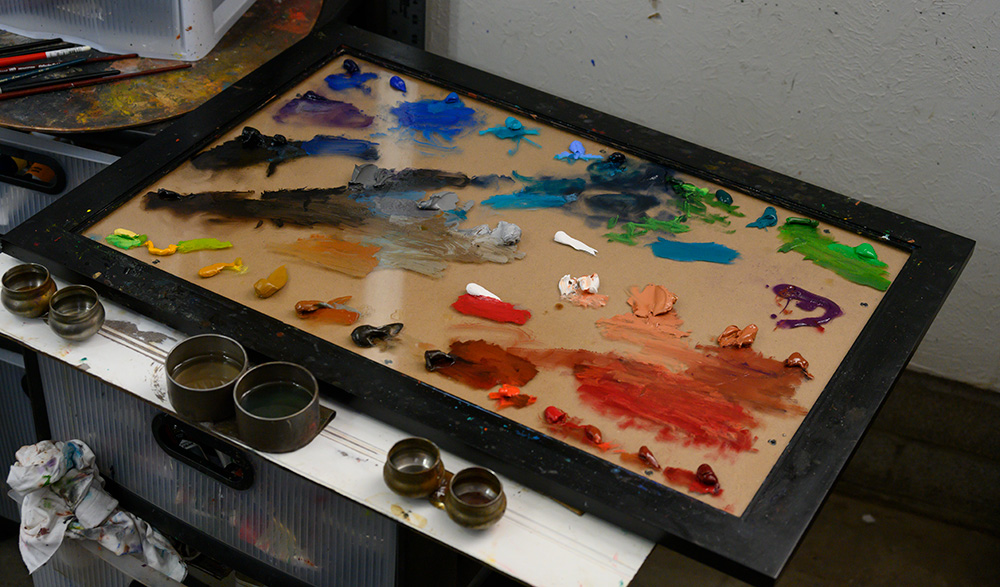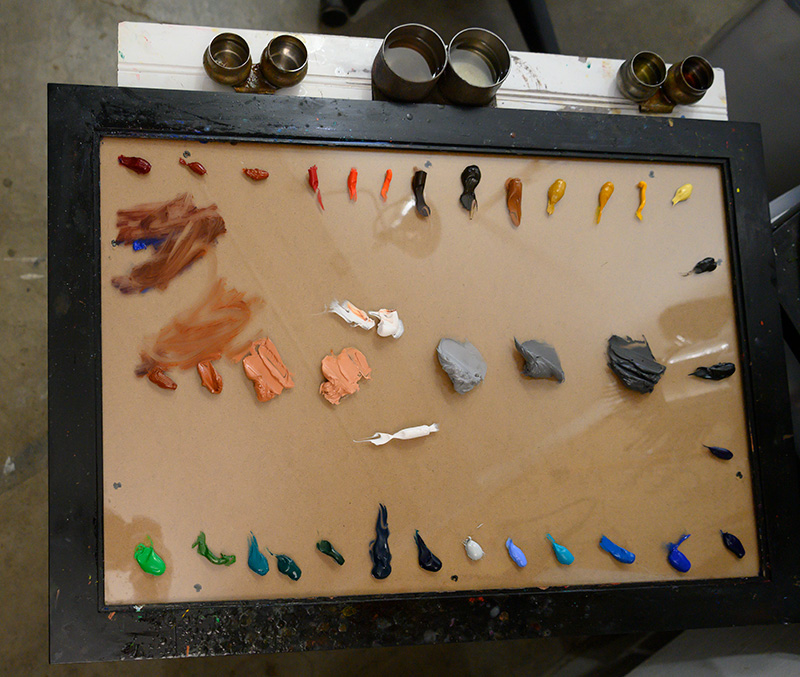
The problem with blended commercial oil paint
The ideal palette consists entirely of single-pigment colors. Such an ideal palette provides artists with total control over values and tones. This is especially important for artists, like me, who use lead white.
These days, even high-end brands use titanium white in their multi-pigment colors. Old Holland, for example, uses a blend of titanium white, zinc white, and ultramarine blue in its King’s Blue.
If I use this King’s Blue with one of my lead-containing tones, the horrid titanium white overpowers the other colors. Worse, such a malformed color appears garish next to the other well-behaved values in the painting. Of course, I can control these unruly colors but why not just mix the thing myself?
The trend among paint manufacturers is toward ever more ‘designer’ colors. Artists must be alert and not assume their paints are single pigment. To pick on Old Holland again, their Naples yellow deep extra is made with a single pigment, PBr24-chrome antimony titanate. Well and good. However, Old Holland offers two other ‘Naples yellows.’ Naples yellow extra is made with a blend of three other pigments–titanium white, zinc white, and mars orange (what happened to the chrome antimony titanate?). To cap off this example, their Naples yellow reddish extra has yet again a different assortment of pigments: diarylide orange, titanium white, nickel titanium yellow, and zinc white.
Old Holland is notorious for offering multiple versions of similarly-named paints, and, as we see here, often with entirely different pigments. If a leading brand like Old Holland is doing this marketing sleight of hand, you can bet the other brands are doing it too.

1 comment
Leave a Reply
Archives
- June 2025
- April 2025
- March 2025
- February 2025
- January 2025
- December 2024
- November 2024
- October 2024
- September 2024
- August 2024
- July 2024
- June 2024
- May 2024
- April 2024
- March 2024
- February 2024
- December 2023
- November 2023
- October 2023
- September 2023
- July 2023
- June 2023
- May 2023
- April 2023
- March 2023
- February 2023
- January 2023
- December 2022
- November 2022
- October 2022
- September 2022
- August 2022
- July 2022
- June 2022
- May 2022
- April 2022
- March 2022
- February 2022
- January 2022
- December 2021
- November 2021
- October 2021
- September 2021
- August 2021
- July 2021
- June 2021
- May 2021
- April 2021
- March 2021
- February 2021
- January 2021
- December 2020
- November 2020
- October 2020
- September 2020
- August 2020
- July 2020
- June 2020
- May 2020
- April 2020
- March 2020
- February 2020
- January 2020
- December 2019
- November 2019
- October 2019
- September 2019
- August 2019
- July 2019
- June 2019
- May 2019
- April 2019
- March 2019
- February 2019
- January 2019
- December 2018
- October 2018
- September 2018
- August 2018
- July 2018
- June 2018
- May 2018
- April 2018
- March 2018
- February 2018
- January 2018
- December 2017
- November 2017
- October 2017
- September 2017
- August 2017
- July 2017
- June 2017
- May 2017
- April 2017
- March 2017
- February 2017
- January 2017
- December 2016
- November 2016
- October 2016
- September 2016
- August 2016
- July 2016
- June 2016
- May 2016
- April 2016
- March 2016
- February 2016
- January 2016
- December 2015
- November 2015
- October 2015
- September 2015
- August 2015
- July 2015
- June 2015
- May 2015
- April 2015
- March 2015
- February 2015
- January 2015
- December 2014
- November 2014
- October 2014
- September 2014
- August 2014
- July 2014
- June 2014
- May 2014
- April 2014
- March 2014
- February 2014
- January 2014
- December 2013
- November 2013
- October 2013
- September 2013
- August 2013
- July 2013
- June 2013
- May 2013
- April 2013
- March 2013
- February 2013
- January 2013
- December 2012
- November 2012
- October 2012
Categories
- aesthetics
- Amusement Park series
- anecdotes
- art boards
- Art history
- Art Museums
- Artists
- Bio
- Books
- cameras
- Cleveland
- computers
- Culture
- current affairs
- Drawings
- etching
- Fiction
- Galleries
- games
- Grumpy review
- How to
- Main Street
- materials
- Movies
- Paintings
- pen and ink
- Photography
- podcast
- Politics
- Reviews
- Shop Talk
- Studio Corner
- thomasparkerhudson.com
- Thumbs-Up-Down
- Tips and Studies
- Turpentine diaries
- Uncategorized
- Vermilion, OH
- video
- war
- writing
- YouTube
In the real world, as opposed to the ideal, there aren’t pigments that fit some points on the color wheel (at excellent saturation/intensity). The most obvious example of this problem is chartreuse (yellow-green). There is no pigment available that provides a high-saturation chartreuse that has artist-grade lightfastness.
The closest thing that was available is PY 157 (Nickel Barium Titanium Primrose Priderite). That pigment isn’t made anymore and it was quite pale (not so saturated), so not really a satisfactory pigment for that spot on the wheel anyway. It was an excellent pigment (once available, for instance, in Holbein’s Nickel Yellow which was actually a green that was strongly yellow-leaning) but that’s beside the point.
Perhaps we might see some of the new Yttrium-based mixed metal pigments give us a good chartreuse. However, so far, the person who has made those (and sells them on Etsy) hasn’t been able to produce useful saturation. What he has made isn’t competitive with a mixture of cadmium lemon and viridian.
There simply is no choice but to offer a mixture when selling a chartruse/green-yellow paint tube. It’s impossible to get the level of chroma/saturation/intensity from a single pigment, with current pigment knowledge.
Imitating pigments that have problems. Real Naples yellows use lead antimoniate, which is a toxicity issue (some countries entirely ban lead pigments, even for professional artists) and which is expensive to procure for artist materials companies. Iron oxides, titanium white, and cadmium yellow/orange are extremely cheap by contrast.
Lead pigments also can darken from exposure to sulfur dioxide air pollution (possibly less of an issue if the painting is varnished).
I have also seen genuine Naples and Lead-Tin (a very similar pigment, chemically) from Robert Doak react with metal palette knives. So, for palette knife painters (and brush painters who work a bit with knives in their paintings) that is a problem. Finding high-quality painting knives that aren’t made with a reactive metal isn’t easy.
Another problem is that no supplier offers the reddish form of genuine Naples yellow anymore. I had several tubes of Kusakabe from the 1940s and that shade was much more pink than what Harding, Rublev, and such offer. That was a wonderful paint but unfortunately the quick-drying nature of it meant that the paint was already semi-dry when I tried to use it — and that was with lead tubes which typically offer better longevity.
Even more dramatic, in terms of problem pigments, are fugitive pigments. Those definitely must be replaced with something else. Almost always, that requires a mixture.
Multi-pigment mixtures are a fact of life, whether one buys tubes with them premade or one does it on the palette. The key is for them to only be offered when they’re necessary. When a chemically stable lightfast pigment with equal or better saturation and the other desired qualities (such as low toxicity) is available, multi-pigment mixtures are typically superfluous. In watercolor, though, special effects can also make them useful, like pigment separation. Another thing they’re used for is to simulate extinct pigments. Artists who have grown to rely upon the way those pigments perform might find a convincing simulation better than having to re-learn their technique more to compensate for the total loss of the shade.
Also, the issue of the titanium white overpowering your mixture would be avoided if the imitation Naples would use lead white or lithopone instead. So, that’s not really a problem inherent in multi-pigment mixtures. It’s a problem with that particular formulation. And, an artist who wants a powerful mixer would prefer having titanium white in the mix.
My biggest complaint about imitation Naples paints is that none of them that I have seen have the same level of chroma and opacity as the genuine lead pigments. However, I haven’t checked all of them. What I’ve seen are bland paints. Winsor & Newton’s, for instance, are very bland. These imitations are also not as lean and dense, so they don’t behave similarly.